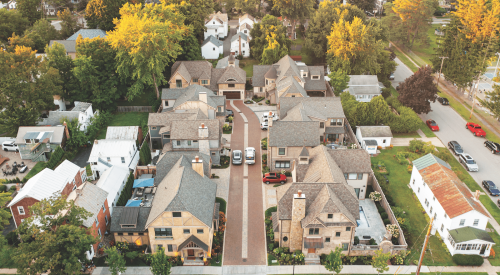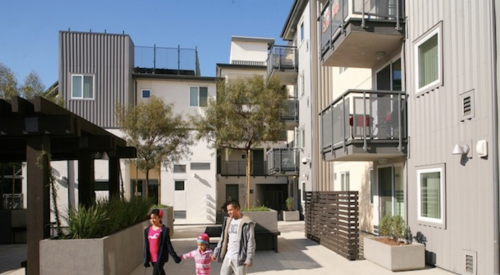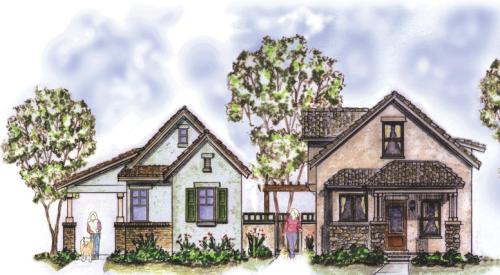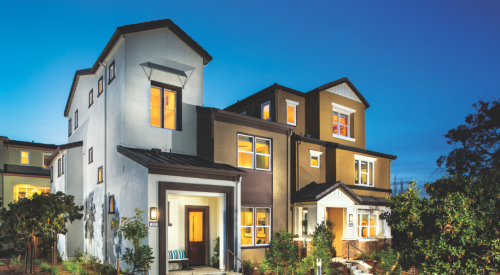 |
|
|
There are plenty of interesting neighborhoods in places throughout the country that are being overlooked. Gopal Ahluwalia, an economist with the National Association of Home Builders, notes the Office of Management and Budget has identified 360 metropolitan areas in the country; 51 percent of the houses in the United States are built in 50 of those metropolitan areas. That's a lot of opportunity.
That said, infill developments are tricky. Steven Brock, founder and CEO of Brock Built in Atlanta, says, "Patience is key. It's not like working in the suburbs. You have to deal with the city's bureaucracy and with scrutiny of neighborhood associations. They can be tough, but their hearts are in the right place."
We've identified builders whose hearts — and cash — were in the right place at the right time.
City Loft Corp.When Harvi Sahota and Anna Lowder bought a dilapidated former A&P grocery store in an old neighborhood of Montgomery, Ala., they noticed how pretty the lots were next to it.
They had to overlook two rundown, 1920 houses that occupied the land. "The lots had some compelling features. They had old growth trees and there was a gentle slope to the land," said Lowder, a partner with Sahota in City Loft Corp. of Montgomery.
 |
| This quaint cottage-style house by City Loft Corp. complemented a mixed-use development in the Old Cloverdale neighborhood in Montgomery, Ala. |
"Infill projects are usually multi-family because land is so expensive. Doing multifamily is a way to bring down land costs," said Steven Hovany, president of Strategy Planning Associates in Schaumburg, Ill.
Infill development of single-family houses presents unique design challenges, but Sahota and Lowder saw the eight houses they would build as a critical part of the multi-use project they were planning in the neighborhood, Old Cloverdale. The quaint, cottage-style design they wanted for the homes and their amenities were affected by the lot sizes, restrictions and the surrounding neighborhood.
Single-family houses allowed Sahota and Lowder to make a smooth transition between the existing neighborhood, which has only single-family houses, and the office/retail and loft spaces
|
|
 |
"We knew from the beginning that this location in such a historic Southern neighborhood required careful transition from mixed-use to stand alone residential," said Sahota.
Cloverdale has Arts and Crafts-style homes, Tudors and a lot of British-inspired architecture; however, details such as cypress wood shutters and clay bricks pay homage to the area's rich Southern heritage.
The houses each have three bedrooms and 2½ bathrooms and sell from $439,000 to $479,000. Two of the eight houses have been sold since they went on the market in October.
Other details of the homes compel buyers.
"Buyers notice the quality of materials and the high standards of architectural details," says Sahota. "We've included custom millwork on mantels, doors and window casings with historical profiles, mahogany front doors, custom cabinetry, 14-foot ceilings and locally made iron stair rails and garden gates and marble counters throughout."
A challenge of fitting the homes on two lots measuring 70 by 240 feet also prompted Sahota and Lowder to make use of other Southern traditions. Instead of garages, the houses have parking arbors, which are cypress-covered, have space for two cars and are not visible from the street.
The site features a central courtyard that separates groups of four houses on each side.
"Because of the layout, you feel like you're hidden away," said Lowder. "It feels secluded. It's kind of like a European village."
And each home also has its own small yard.
"The size of the side yards and gardens were impacted in the design," said Sahota. "That turned out to be a good thing. We found buyers don't really want a lot of yard. They want a smaller garden that they can just put stones over if they want and be done with it."
Brock BuiltIf anyone knows about the challenges of fitting houses on small properties, as well as large ones, it's Steven Brock. As founder and CEO of Brock Built in Atlanta, he has been building homes on urban infill properties for 23 years.
"We're always on the look-out for emerging neighborhoods," he said. "Those opportunities may be in a rundown old house on a small lot or in an industrial property with an obsolete warehouse that we can take down."
One of Brock's more intimate projects is 8 on Carroll, a development of eight single-family homes in Atlanta with a view that would appeal to urban pioneers who seek a gritty city view.
"It's a very urban setting. You can go back on your back deck and have a view of the Inman Rail Yard," he says.
When it comes to building houses, small, irregularly shaped or unique pieces of property are not a
 |
 |
| Houses in the first phase of Legacy Square in Parkl Forest, Ill., boast bay windows and wide front porches. |
"Sometime people think I'm crazy. I build houses on the freeway, on the railroad. We shoehorn them in," he says.
Brock tore down three rundown houses that had occupied the property of 8 on Carroll. The site presented many design challenges.
"The lots are 50-feet wide. It's a very steep topography, so we built a 20-foot-high retaining wall at the back of it," he says.
The houses have front-loaded garages — "There was no way we could put a rear-entry garage on those [lots]," he says — and charming front porches. Other amenities include family rooms with fireplaces; large decks; and kitchens with granite counters and stainless steel appliances.
Brock said all of his houses have yards.
"We try to put a little yard with every house. It may be a small yard, but it allows people to live in- town in a great location and have their bit of open space."
The houses in 8 on Carroll are priced in the mid-$300,000s and are designed in a Craftsman bungalow style. He wanted to complement the look of existing, nearby houses and to be in step with DuPont Commons, another much larger infill development that Brock is constructing nearby. It features single-family houses in a bungalow style, condos and townhouses.
"When we go into a neighborhood, we look at the architecture of the surrounding community. We try to a create design that's compatible with what is already there," he said.
Brock says the demand for single-family houses in infill properties is there because buyers see their value. Locations close to expressways, public transportation and other services lure home buyers. And many are not interested in the hassle and cost of an older house.
Bigelow HomesAnother builder in the Chicago area, Bigelow Homes, is just as confident as Brock about the market for single-family homes in infill situations. The company is preparing to construct the second phase of Legacy Square in Park Forest, Ill., a suburban community just 30 miles south of Chicago.
Michael Venetis, vice president of sales and marketing for Bigelow, expects a range of buyers from young professionals to empty nesters to families to live in Legacy Square.
"It's a draw for families because infill neighborhoods tend to have better amenities and better schools. If you go to an outlying area, there's not much out there for kids to do, or for adults for that matter," he said.
The 88 homes will replace two shuttered department stores and a parking lot.
At Legacy Square, the houses will evoke a quaint feeling of a small-town neighborhood. They will have porches, bay windows and second-story balconies in a traditional style.
Builders of single-family houses on infill properties face challenges that builders in the open fields of farflung suburban subdivisions do not. They have to be more innovative in terms of floor plans.
"When you have a bunch of land to build on you don't have to be as detailed with the floor plans. You don't have to be as efficient," Venetis said.
 |
| Ground level shops and boutiques create a vital streetscape in Montgomery, Ala. |
"We got real smart with the layouts so we can fill a lot of useable space into that square footage," he said.
"The rooms are not chopped up visually so they look bigger."
Janko GroupJanko Group has purchased a former nine-hole golf course in Addison, Ill., where it plans to build a community targeted to active adults age 55 and over.
The development will have 31 single-family homes with 1,800 to 2,400 square feet priced in the low- to mid-$500,000 range.
"Residents are interested in downsizing their square footage. But they don't want to downsize the quality of their lives," says Kevin Michaeli, president of land acquisition.
Officials in the community northwest of Chicago are hoping that the development, which will also feature 58 duplexes and 100 condos, will aid them in revitalizing their downtown business district.
The houses will come in two-story or ranch-style plans and will feature elements geared toward empty nesters, such as first-floor master bedrooms, open floor plans and wide hallways.
If Michaeli's experience is anything like Brock's in Atlanta, then that goal of sparking redevelopment of a neighborhood will be realized. Brock said his role as an urban pioneer has led to an increase in prices of his houses and a rejuvenation of neighborhoods that once were considered rundown.
"The houses I built 10 years ago are selling for three times the price I sold them for," Brock said.














